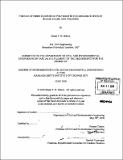The use of fiber reinforced polymers in the rehabilitation of beams, slabs, and columns
Author(s)
St. Hilaire, Shaun P. (Shaun Paul)
DownloadFull printable version (11.01Mb)
Other Contributors
Massachusetts Institute of Technology. Dept. of Civil and Environmental Engineering.
Advisor
Jerome Connor.
Terms of use
Metadata
Show full item recordAbstract
Structures throughout the United States, especially those made of reinforced concrete, have been rapidly aging and are in dire need of repair. Given the circumstances it is only natural that new, more efficient technologies, such as fiber reinforced polymer (FRP) materials, emerge to solve this worldwide aging infrastructure. FRP systems have the ability to be customized through the use of different FRP configurations, installations, and also different material properties. Through the suggested design procedures, engineers have the ability to determine the level of capacity of these existing systems and then assess and design for their future needs. Whether reinforced concrete structures are comprised of beams, columns, or slabs, FRP's can be used to improve strength and ductility while benefiting from a large service life extension. The engineer should evaluate all aspects of the project, including the structures location. The natural environment has the ability to degrade these FRP materials depending on the exposure to different elements, as well as, the duration of time exposed to these elements over the life of the system. The material should be chosen and designed with these considerations in mind to maximize the benefits of this rehabilitation technique.
Description
Thesis (M. Eng.)--Massachusetts Institute of Technology, Dept. of Civil and Environmental Engineering, 2008. Includes bibliographical references (leaves 54-55).
Date issued
2008Department
Massachusetts Institute of Technology. Department of Civil and Environmental EngineeringPublisher
Massachusetts Institute of Technology
Keywords
Civil and Environmental Engineering.